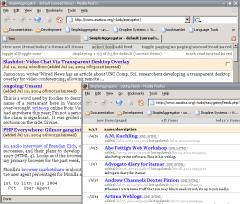I haven't posted anything in a long while since I've been pretty busy working on a complex project in my spare time (let's call it project X), and I've not had Internet access outside office hours for the past couple of months. I hope to start writing again frequently soon, since I'm learning interesting things for project X which involves SMIME and SMTP mail (using OpenSSL, M2Crypto and the email package).
This brief note, done mainly so that I can use it as a reference in the future, regards customizing logging.LogRecord. One of the requirements of project X is that all operations for a single transaction are logged with a unique timestamp, representing the start of the transaction. Since I'm lazy, and I don't trust myself too much when writing code (especially at late hours), I did not want to have to carry around this value everywhere, and remember to pass it to every logging call.
So last night I had a look into the logging internals, to see how to extend logging.LogRecord to carry an additional argument representing my unique timestamp. Apart from being very useful, the logging package is very well architected, so it turns out subclassing LogRecord is not too difficult. Let's see one way of doing it, which is not necessarily the best one so please send me any improvements/suggestions.
LogRecord instances are
created every time something is logged. They contain all the information pertinent to the event being logged. [...]
LogRecord has no methods; it's just a repository for information about the logging event. The only reason it's a class rather than a dictionary is to facilitate extension.
LogRecord objects are created by makeRecord, a factory method of the logging.Logger class. To use a custom subclass of LogRecord, you have to subclass logging.Logger and override makeRecord, then set your subclassed Logger class as logging's default which is not too hard.
When you call logging.getLogger(name) to get a new logger instance, the getLogger function calls Logger.manager.getLogger(name). Manager.getLogger (Logger.manager is Manager(Logger.root)) does a bunch of stuff, then if no loggers with the same name have been already created, it returns a new instance of _loggerClass for the given name. logging._loggerClass is set by default as _loggerClass = Logger. So to set your Logger subclass as logging's default, just call:
logging.setLoggerClass(CustomLogger)
Now that we know what to subclass and how to set logging to use it, we still have to decide how to pass the extra argument to LogRecord. To pass it to our CustomLogger class as an additional __init__ argument we would have to subclass logging.Manager and override getLogger, which seems a bit too much work. Another option would be to directly set the extra parameter in every newly obtained CustomLogger instance, but then you would have to remember to set it every time, since logging raises a KeyError exception if you'd try to use the missing parameter as a string format (you could also set it to a default value in CustomLogging.__init__, but then you'd get a default value in your logs which IMHO is even worse). The way I choose to do it is to set the parameter in logging.root so that my extra argument is available to all loggers since they share a reference to the root logger. To make the root logger emit CustomLogRecord instances, I redefined logging.RootLogger.MakeRecord to match CustomLogger.MakeRecord.
This solution obviously won't work if you need to set different extra arguments for different loggers, and my custom classes manage only a single extra argument, which is exactly what I need for this project but may not be enough for other cases.
#!/usr/bin/python
import logging
from time import strftime, gmtime
class CustomLogRecord(logging.LogRecord):
"""
LogRecord subclass that stores a unique -- transaction -- time
as an additional attribute
"""
def __init__(self, name, level, pathname, lineno, msg, args, exc_info, trans_time):
logging.LogRecord.__init__(self, name, level, pathname, lineno, msg, args, exc_info)
self.trans_time = trans_time
def makeRecord(self, name, level, fn, lno, msg, args, exc_info):
return CustomLogRecord(name, level, fn, lno, msg, args, exc_info, self.root.trans_time)
class CustomLogger(logging.Logger):
"""
Logger subclass that uses CustomLogRecord as its LogRecord class
"""
def __init__(self, name, level=logging.NOTSET):
logging.Logger.__init__(self, name, level)
makeRecord = makeRecord
# setup
logging.setLoggerClass(CustomLogger)
logging.root.trans_time = strftime("%a, %d %b %Y %H:%M:%S +0000", gmtime())
logging.RootLogger.makeRecord = makeRecord
if __name__ == '__main__':
# get logger
logger = logging.getLogger('modified logger')
logger.propagate = False
hdlr = logging.StreamHandler()
hdlr.setFormatter(logging.Formatter(
'%(trans_time)s [%(asctime)s] %(levelname)s %(process)d %(message)s'))
logger.addHandler(hdlr)
logger.setLevel(logging.DEBUG)
logging.root.addHandler(hdlr)
logger.debug('test')
from time import sleep
sleep(1)
logger.debug('a second test, with (hopefully) the same date as the previous log record')
logging.warn('root logging')
The output of the above script should be something like:
Tue, 18 May 2004 12:53:04 +0000 [2004-05-18 14:53:04,898] DEBUG 31268 test
Tue, 18 May 2004 12:53:04 +0000 [2004-05-18 14:53:05,898] DEBUG 31268 a second test,
with (hopefully) the same date as the previous log record
Tue, 18 May 2004 12:53:04 +0000 [2004-05-18 14:53:05,898] WARNING 31268 root logging

